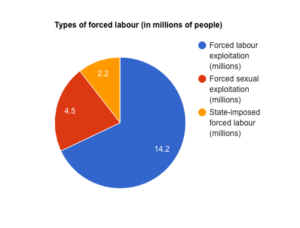The World Day Against Trafficking in Persons on July 30 seeks to find justice for the approximately 21 million people trafficked annually around the world.
Empathetic Media has partnered with the ATTeam of the Red Cross of Pancevo in Serbia to raise awareness about the issue of modern human slavery. The story, entitled “#STOPtrafficking2016”, will be hosted on Empathetic Media’s free app, ARc Stories, the first augmented reality (AR) sequential storytelling app. You can learn more about the project here. One of the goals of this project was to not only tell the story of modern day slavery, but also tackle stereotypes about trafficking. Below are five facts about human trafficking.
Human trafficking is a global issue.

Map of human trafficking by region. Source: ILO
According to the United Nations, at least 127 of the 195 recognized countries have reported incidents of trafficking in 2016. In addition, much trafficking occurs across borders. Annually, approximately 600,000-800,000 people are trafficked internationally, with half of those being children.
There is also a persistent stereotype that human trafficking only happens in parts of the Global South. But since 2007, the National Human Trafficking Resource Center has helped with 27,775 cases in the United States that involved at least 28,399 victims. In addition, between 14,500 and 17,500 people are trafficked into the U.S. each year.
It is not all sex trafficking.

Source: ILO
Of the 18.7 million people trafficked in the private market, 4.5 million or 22 percent are victims of forced sexual exploitation. While it is significant, sexual slavery is only one form of trafficking. The International Labor Organization states that domestic work, agriculture, construction, manufacturing and entertainment are also potential areas for human trafficking.
Men are also trafficked in large numbers.
While it is a stereotype that trafficking affects women significantly more than men, of the almost 21 million people trafficked annually, 11.4 million are women and girls and 9.5 million are men and boys. In particular, forced labor and manufacturing are areas in which men are heavily trafficked. To learn more, read this Los Angeles Times investigation into Mexico’s mega-farms that use forced labor to supply produce to the United States.
It isn’t just part of the private economy.
While the majority of traffickers are individuals and private enterprises, 2.2 million trafficked person are in state-imposed forms of forced labour, including prions, state military and rebel armed forces. In addition, 27 countries, mostly in the Global South, are on the U.S. State Department’s Tier 3 watch list, which means they do not meet the minimum standards to prevent and persecute human trafficking.

